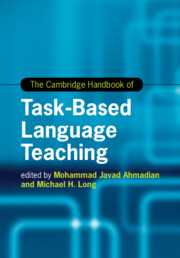Book contents
- The Cambridge Handbook of Task-Based Language Teaching
- Cambridge Handbooks In Language And Linguistics
- The Cambridge Handbook of Task-Based Language Teaching
- Copyright page
- Dedication
- Contents
- Figures
- Tables
- Contributors
- Preface The Origins and Growth of Task-Based Language Teaching
- Part I The Rationale for Task-Based Language Teaching
- Part II Tasks and Needs Analysis
- Part III The Task Syllabus and Materials
- Part IV Methodology and Pedagogy
- 9 A Psycholinguistically Motivated Methodology for Task-Based Language Teaching
- 10 Technology-Mediated Task-Based Language Teaching
- 10A Delivering Task-Based Language Teaching at Scale
- 10B Task-Based Language Teaching and Indigenous Language Revitalisation
- 10C Task-Based Simulations for Diplomatic Security Agents
- Part V Task-Based Language Teaching with School-Age Children
- Part VI The Teacher in Task-Based Language Teaching
- Part VII Task-Based Assessment and Program Evaluation
- Part VIII Research Needs and Future Prospects
- Index
- References
10B - Task-Based Language Teaching and Indigenous Language Revitalisation
from Part IV - Methodology and Pedagogy
Published online by Cambridge University Press: 19 November 2021
- The Cambridge Handbook of Task-Based Language Teaching
- Cambridge Handbooks In Language And Linguistics
- The Cambridge Handbook of Task-Based Language Teaching
- Copyright page
- Dedication
- Contents
- Figures
- Tables
- Contributors
- Preface The Origins and Growth of Task-Based Language Teaching
- Part I The Rationale for Task-Based Language Teaching
- Part II Tasks and Needs Analysis
- Part III The Task Syllabus and Materials
- Part IV Methodology and Pedagogy
- 9 A Psycholinguistically Motivated Methodology for Task-Based Language Teaching
- 10 Technology-Mediated Task-Based Language Teaching
- 10A Delivering Task-Based Language Teaching at Scale
- 10B Task-Based Language Teaching and Indigenous Language Revitalisation
- 10C Task-Based Simulations for Diplomatic Security Agents
- Part V Task-Based Language Teaching with School-Age Children
- Part VI The Teacher in Task-Based Language Teaching
- Part VII Task-Based Assessment and Program Evaluation
- Part VIII Research Needs and Future Prospects
- Index
- References
Summary
Task-based language teaching (TBLT) aims to help learners meet “present and future real-world communicative needs” (Long, 2015: 68). In Indigenous language revitalisation contexts, however, there may not be a real-world need to speak the target language, due to a lack of speakers or the widespread bilingualism associated with particular stages of language loss. Drawing on two distinct but complementary contexts, Macuiltianguis Zapotec after-school lessons (Oaxaca, Mexico) and a workshop for teachers at a Salish Qlispe immersion school (Montana, United States), we show how TBLT might be adapted for language revitalisation through the conscious creation of new spaces for meaningful communication in the target language. The Zapotec and Salish contexts represent different approaches to adapting TBLT for Indigenous language instruction. The Zapotec teachers looked for everyday communicative tasks that learners plausibly could do in Zapotec, focusing on encouraging students to speak Zapotec in situations in which they were already interacting with Zapotec speakers in the community but doing so in Spanish. The Salish teachers, on the other hand, focused on the school itself as a new space for meaningful language use. We describe how task-based methodological principles (Long, 2009, 2015) were useful for planning and teaching in these settings.
Keywords
Information
- Type
- Chapter
- Information
- The Cambridge Handbook of Task-Based Language Teaching , pp. 359 - 373Publisher: Cambridge University PressPrint publication year: 2021
